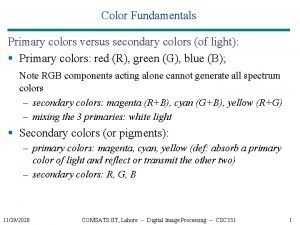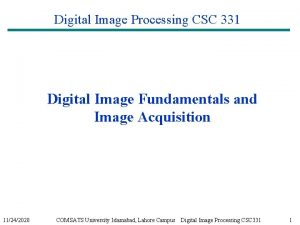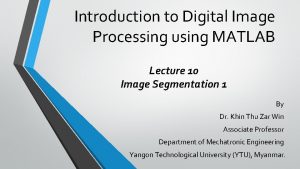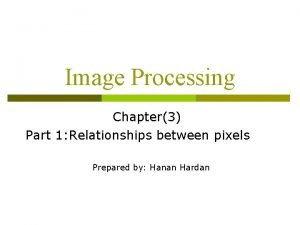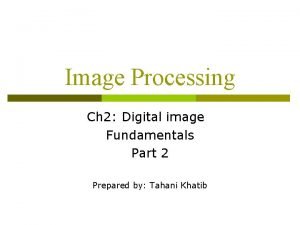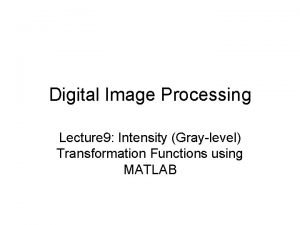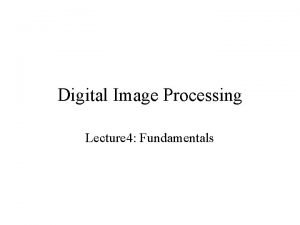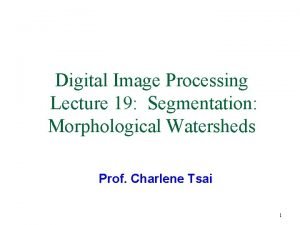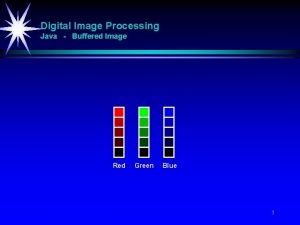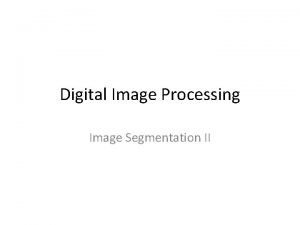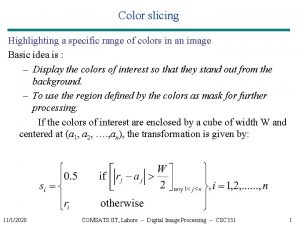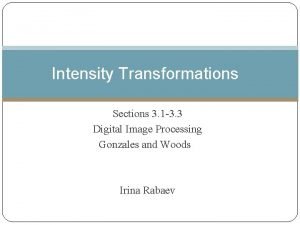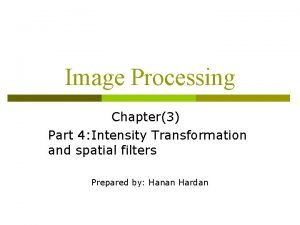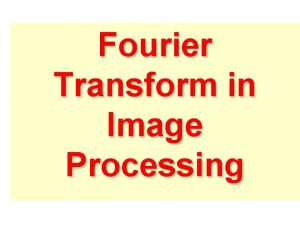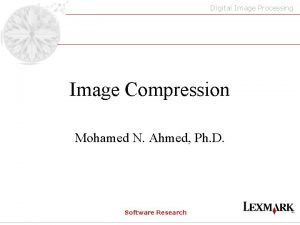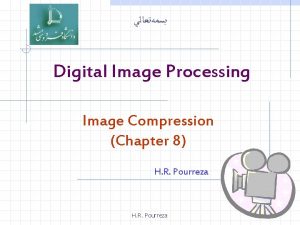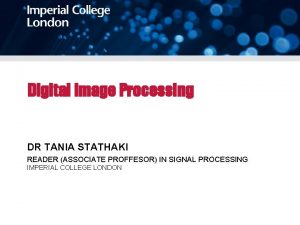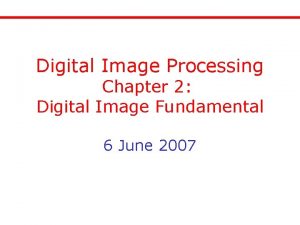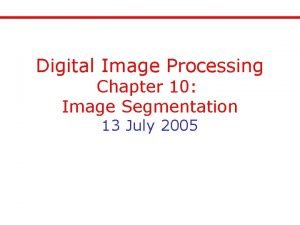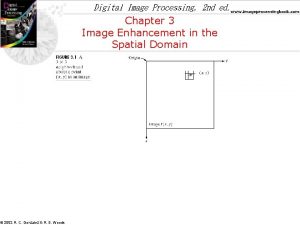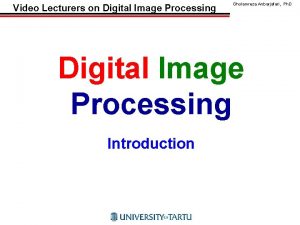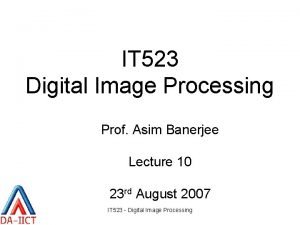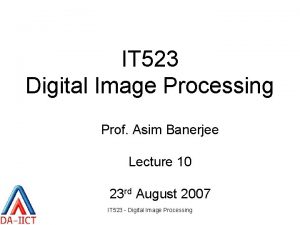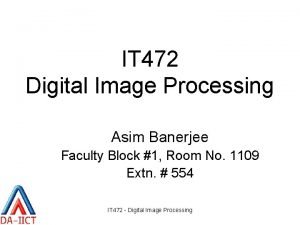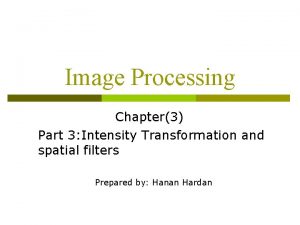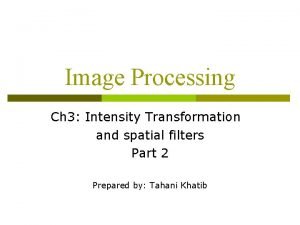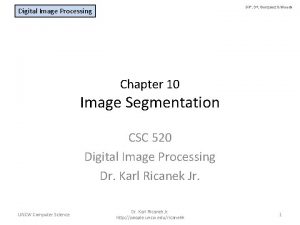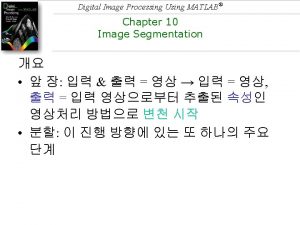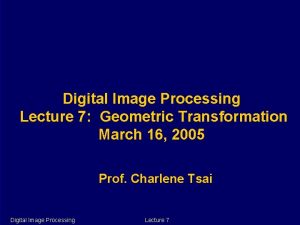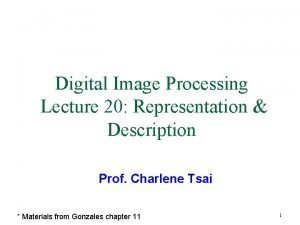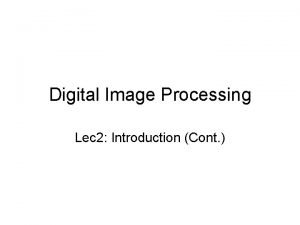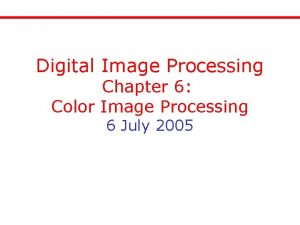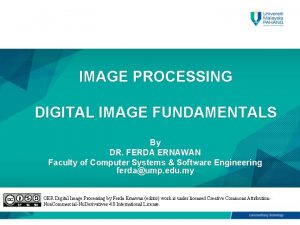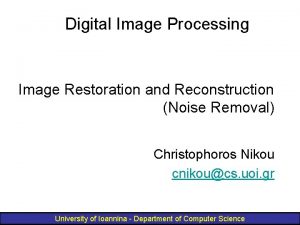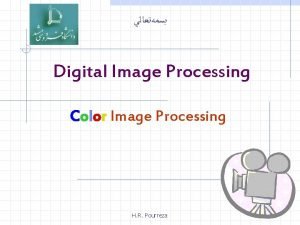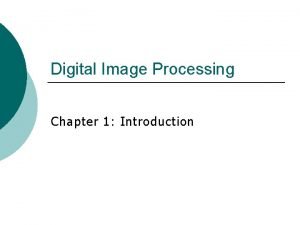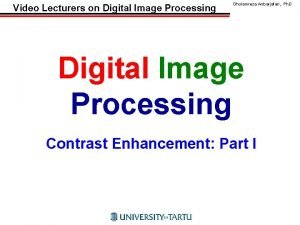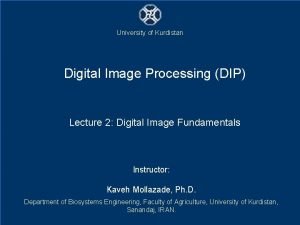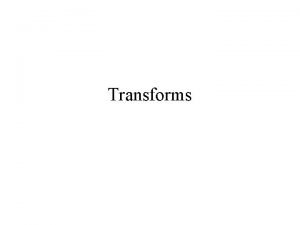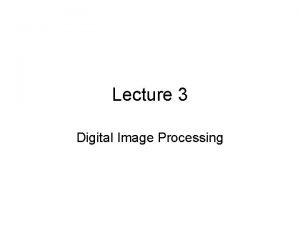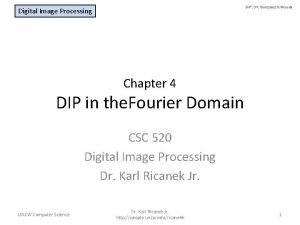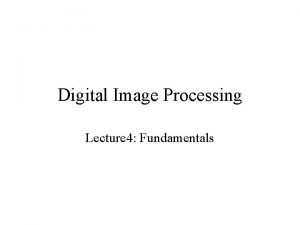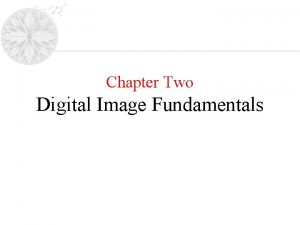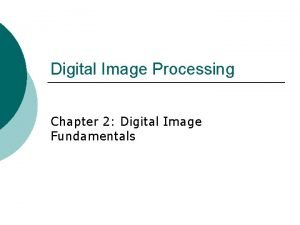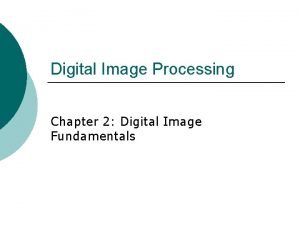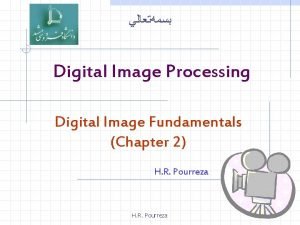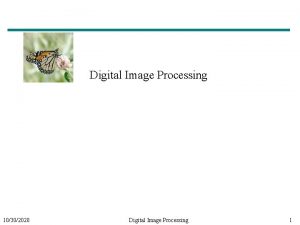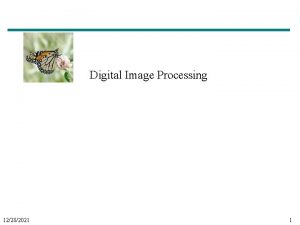Digital Image Processing Module 1 DIGITAL IMAGE FUNDAMENTALS














































































- Slides: 78

Digital Image Processing Module 1 DIGITAL IMAGE FUNDAMENTALS Prepared by K. Indragandhi, AP(Sr. Gr. )/ECE

References 1. Rafael C. Gonzalez and Richard E. Woods, “Digital Image Processing”, Pearson Education, Inc. , Second Edition, 2004. 2. Anil K. Jain, “Fundamentals of Digital Image Processing”, Prentice Hall of India, 2002. 3. William K. Pratt, “Digital Image Processing”, 2 nd Edition, Wiley & Sons, Inc. , 1991.

• What is an Image? Picture, photograph Visual data Usually two or three dimensional What is a digital image? An image which is “discretized, ”, i. e. , defined on a discrete grid Two-dimensional collection of light values (or gray values)

Basic Terminology What is a digital image? • A representation of the original image by a discrete set of data points • Each of these data points is called a picture element, commonly referred to as a “pixel”

Digital Image Generation Generating a digital image • Place a regular 2 D grid over an image and read the colour value • at the intersections of the grid => set of data points for that image

What is digital image processing? Digital image processing is the study of representation and manipulation of pictorial information by a computer. Improve pictorial information for better clarity (human interpretation) Automatic machine processing of scene data (interpretation by a machine/non-human, storage, transmission) What is image interpetation? Assign meaning to an ensemble of recognized objects

Digital Image Digital image = a multidimensional array of numbers (such as intensity image) or vectors (such as color image) Each component in the image called pixel associates with the pixel value (a single number in the case of intensity images or a vector in the case of color images).

Important steps in a typical image processing system Step 1: Image acquisition Capturing visual data by an image sensor Step 2: Discretization / digitalization; Quantization ; Compression Convert data into discrete form; compress for efficient storage/transmission Step 3: Image enhancement and restoration Improving image quality (low contrast, blur noise) Step 4: Image segmentation Partition image into objects or constituent parts

Chapter 1: Introduction

Chapter 1: Introduction

ü Image enhancement and restoration both involve techniques to make a better image ü Image compression involves development of techniques to make smaller files, while still retaining high quality images

ELEMENTS OF VISUAL PERCEPTION

ELEMENTS OF VISUAL PERCEPTION Human Visual Perception

The Human Eye • Diameter: 20 mm • 3 membranes enclose the eye – Cornea & sclera – Choroid – Retina

The Choroid • The choroid contains blood vessels for eye nutrition and is heavily pigmented to reduce extraneous light entrance and backscatter. • It is divided into the ciliary body and the iris diaphragm, which controls the amount of light that enters the pupil (2 mm ~ 8 mm).

The Lens • The lens is made up of fibrous cells and is suspended by fibers that attach it to the ciliary body. • It is slightly yellow and absorbs approx. 8% of the visible light spectrum. • The lens contains 60 -70% water, 6% of fat.

The Retina • The retina lines the entire posterior portion. • Discrete light receptors are distributed over the surface of the retina: – cones (6 -7 million per eye) and – rods (75 -150 million per eye)

Cones • Cones are located in the fovea and are sensitive to color. • Each one is connected to its own nerve end. • Cone vision is called photopic (or bright-light vision or day vision). • There are three types of cones: Red, Green, and Blue

Rods ü Rods are giving a general, overall picture of the field of view ü They see only brightness (not color) and are not involved in color vision. • Several rods are connected to a single nerve and are sensitive to low levels of illumination (scotopic or dim-light vision or night vision).

MESOPIC VISION • Intermediate region of illumination – between dim and bright light • Both rods and cones are active

Receptor Distribution • The distribution of receptors is radially symmetric about the fovea. • Cones are most dense in the center of the fovea while rods increase in density from the center out to approximately 20% off axis and then decrease.

Cones & Rods

The Fovea • The fovea is circular (1. 5 mm in diameter) but can be assumed to be a square sensor array (1. 5 mm x 1. 5 mm). • The density of cones: 150, 000 elements/mm 2 ~ 337, 000 for the fovea. • A CCD imaging chip of medium resolution needs 5 mm x 5 mm for this number of elements

BLIND SPOT • Blind spot is the region of emergence of the optic nerve from the eye • Place on the retina where optic nerve connects, and which consists of no light sensors

Image Formation in the Eye • The eye lens (if compared to an optical lens) is flexible. • It gets controlled by the fibers of the ciliary body and to focus on distant objects it gets flatter (and vice versa).

Image Formation in the Eye • Distance between the center of the lens and the retina (focal length): – varies from 17 mm to 14 mm (refractive power of lens goes from minimum to maximum). • Objects farther than 3 m use minimum refractive lens powers (and vice versa).

Image Formation in the Eye • Example: – Calculation of retinal image of an object

Image Formation in the Eye

Image Formation in the Eye • Perception takes place by the relative excitation of light receptors. • These receptors transform radiant energy into electrical impulses that are ultimately decoded by the brain.

LUMINANCE OR INTENSITY • Emitting or reflecting light from the object • The luminance of an object is independent of the luminance of the surrounding objects

BRIGHTNESS • Brightness is the perceived luminance • Depends on the luminance of the surround • Two objects with different surroundings could have identical luminance but different brightness

CONTRAST • Contrast is the difference in visual properties that makes an object (or its representation in an image) distinguishable from other objects and the background • Contrast is determined by the difference in the color and brightness of the light reflected or emitted by an object and other objects within the same field of view.

Brightness Adaptation of Human Eye (cont. ) Simultaneous contrast. All small squares have exactly the same intensity but they appear progressively darker as background becomes lighter.

HUE • The hue of a color refers to its “redness”, “greenness” and so on. • A hue refers to the gradation of color within the optical spectrum, or visible spectrum, of light. • "Hue" may also refer to a particular color within this spectrum, as defined by its dominant wavelength, • or the central tendency of its combined wavelengths. For example, a light wave with a central tendency within 565 -590 nm will be yellow.

SATURATION • Saturation refers to the intensity of a specific hue. • In art or when working with colors, saturation is the amount of color a certain color has. For example, black and white have no saturation and bright red has 100% saturation

MACH BAND EFFECT • The spatial interaction from an object and its surroundings creates a phenomenon called mach band effect. • The visual system tends to undershoot or overshoot around the boundary of regions of different intensities

Brightness Adaptation of Human Eye (cont. ) A Intensity B Position In area A, brightness perceived is darker while in area B is brighter. This phenomenon is called Mach Band Effect.

MACH BAND EFFECT

• Although the intensity of the stripes is constant, we actually perceive a brightness pattern that is strongly scalloped, especially near the boundaries • These scalloped bands are called mach bands

RGB Model • An additive colour model, based on three components: red(R), green (G) and Blue (B). • 8 bits are usually used for each colour (=> 24 bits total) • These can be stored (in memory) as 3 separate colour planes. . • . . . or in an ‘interlaced form’, with each pixel represented with 3 bytes (24 bits) sequentially.

But!!!!! Not all colours can be represented by the RGB system However It is probably good enough to fool the human vision system

The RGB Cube B Blue Cyan Magenta Green Red R Yellow G

The HSI Model (an alternative to RGB) • Hue, H, specifies the dominant pure colour perceived by the observer (e. g. red, yellow, blue) [i. e. a representation of the frequency/wavelength] • Saturation, S, specifies the degree to which a pure colour has been diluted by white light to produce observed colour. • Intensity, I, is related to the perceived brightness of the colour. N. B. Decoupling (separating) intensity from colour is very useful in image manipulation and analysis as increased/decreased lighting in a scene (more or less) only effect this parameter.

The HSI Cone Intensity White Hue Green Yellow Cyan Red Saturation Blue Magenta Black

A Simple Image Model • Image: a 2 -D light-intensity function f(x, y) • The value of f at (x, y) the intensity (brightness) of the image at that point • 0 < f(x, y) <

Digital Image Acquisition

A Simple Image Model • Nature of f(x, y): – The amount of source light incident on the scene being viewed – The amount of light reflected by the objects in the scene

A Simple Image Model • Illumination & reflectance components: – Illumination: i(x, y) – Reflectance: r(x, y) – f(x, y) = i(x, y) r(x, y) – 0 < i(x, y) < and 0 < r(x, y) < 1 (from total absorption to total reflectance)

A Simple Image Model • Sample values of r(x, y): – 0. 01: black velvet – 0. 93: snow • Sample values of i(x, y): – 9000 foot-candles: sunny day – 1000 foot-candles: cloudy day – 0. 01 foot-candles: full moon

Create an image To create a digital image, we need to convert the continuously sensed data into digital form. This involves: Sampling: Digitizing the coordinate values (resolution) Depends on density of sensor in an array Limited by optical resolution Quantization (bits/pixel) • Digitizing the amplitude values Pixel: short for picture element

Sampling & Quantization • The spatial and amplitude digitization of f(x, y) is called: – image sampling when it refers to spatial coordinates (x, y) and – gray-level quantization when it refers to the amplitude.

Digital Image

Sampling and Quantization

A Digital Image

Sampling & Quantization Digital Image Elements (Pixels)

Sampling & Quantization • The digitization process requires decisions about: – values for N, M (where N x M: the image array) and – the number of discrete gray levels allowed for each pixel.

Sampling & Quantization • Usually, in DIP these quantities are integer powers of two: N=2 n M=2 m and G=2 k number of gray levels • Another assumption is that the discrete levels are equally spaced between 0 and L-1 in the gray scale.

Examples

Examples

Examples

Examples

Sampling & Quantization • If b is the number of bits required to store a digitized image then: – b = N x M x k (if M=N, then b=N 2 k)

Storage

Sampling & Quantization • How many samples and gray levels are required for a good approximation? – Resolution (the degree of discernible detail) of an image depends on sample number and gray level number. – i. e. the more these parameters are increased, the closer the digitized array approximates the original image.

Sampling & Quantization • How many samples and gray levels are required for a good approximation? (cont. ) – But: storage & processing requirements increase rapidly as a function of N, M, and k

Sampling & Quantization • Different versions (images) of the same object can be generated through: – Varying N, M numbers – Varying k (number of bits) – Varying both

Sampling & Quantization • Conclusions: – Quality of images increases as N & k increase – Sometimes, for fixed N, the quality improved by decreasing k (increased contrast) – For images with large amounts of detail, few gray levels are needed

Dithering • Full-color photographs may contain an almost infinite range of color values • Dithering is the attempt by a computer program to approximate a color from a mixture of other colors when the required color is not available • Dithering is the most common means of reducing the color range of images down to the 256 (or fewer) colors seen in 8 -bit GIF images


• Most images are dithered in a diffusion or randomized pattern to diminish the harsh transition from one color to another • But dithering also reduces the overall sharpness of an image, and it often introduces a noticeable grainy pattern in the image • This loss of image detail is especially apparent when fullcolor photos are dithered down to the 216 -color browser -safe palette.


TWO DIMENSIONAL MATHEMATICAL PRELIMINARIES

Review: Matrices and Vectors Definitions (Con’t) A column vector is an m × 1 matrix: A row vector is a 1 × n matrix: A column vector can be expressed as a row vector by using the transpose: 73

Review: Matrices and Vectors Some Basic Matrix Operations • The sum of two matrices A and B (of equal dimension), denoted A + B, is the matrix with elements aij + bij. • The difference of two matrices, A B, has elements aij bij. • The product, AB, of m×n matrix A and p×q matrix B, is an m×q matrix C whose (i, j)-th element is formed by multiplying the entries across the ith row of A times the entries down the jth column of B; that is, 74

Review: Matrices and Vectors Some Basic Matrix Operations (Con’t) The inner product (also called dot product) of two vectors is defined as Note that the inner product is a scalar. 75

TOEPLITZ MATRIX, CIRCULANT MATRIX • It has a constant elements along the main diagonal and the sub diagonals • Circulant matrix – each of its rows (or columns) is a circular shift of the previous row(or column) 76

ORTHOGONAL AND UNITARY MATRICES • An orthogonal matrix is such that its inverse is equal to its transpose A-1 = AT • A Matrix is called unitary if its inverse is equal to its conjugate transpose A-1 = A*T 77

BLOCK MATRIX • Any matrix whose elements are matrices themselves is called a block matrix. 78
 Color fundamentals in digital image processing
Color fundamentals in digital image processing Histogram processing in digital image processing
Histogram processing in digital image processing Neighborhood processing in image processing
Neighborhood processing in image processing Nonlinear image processing
Nonlinear image processing Point processing
Point processing Point processing in image processing example
Point processing in image processing example Morphological dilation
Morphological dilation Image transform in digital image processing
Image transform in digital image processing Noise
Noise Spatial and temporal redundancy in digital image processing
Spatial and temporal redundancy in digital image processing Key stage in digital image processing
Key stage in digital image processing Fidelity criteria in digital image processing
Fidelity criteria in digital image processing Image sharpening in digital image processing
Image sharpening in digital image processing Image geometry in digital image processing
Image geometry in digital image processing The range of values spanned by the gray scale is called:
The range of values spanned by the gray scale is called: Digital image processing
Digital image processing Maketform
Maketform Image restoration in digital image processing
Image restoration in digital image processing Image processing
Image processing Boundary descriptors in digital image processing
Boundary descriptors in digital image processing Representation and description in digital image processing
Representation and description in digital image processing Double thresholding matlab
Double thresholding matlab Segmentation in digital image processing
Segmentation in digital image processing 4 adjacency and 8 adjacency pixels example
4 adjacency and 8 adjacency pixels example Basic intensity transformation in digital image processing
Basic intensity transformation in digital image processing For coordinates p(2,3)the 4 neighbors of pixel p are
For coordinates p(2,3)the 4 neighbors of pixel p are Gray level transformation in digital image processing
Gray level transformation in digital image processing 8 adjacency in image processing
8 adjacency in image processing Coordinate conventions in digital image processing
Coordinate conventions in digital image processing Dam construction in image processing
Dam construction in image processing Digital image processing java
Digital image processing java Thresholding in digital image processing
Thresholding in digital image processing Segmentation in digital image processing
Segmentation in digital image processing In digital image processing
In digital image processing Topological descriptors in image processing
Topological descriptors in image processing Thresholding in digital image processing
Thresholding in digital image processing What is boundary descriptors in digital image processing
What is boundary descriptors in digital image processing What is color slicing
What is color slicing Tungsten filament
Tungsten filament Types of spatial filtering in digital image processing
Types of spatial filtering in digital image processing Math review
Math review Matlab pad image
Matlab pad image Digital image processing
Digital image processing Hotelling transform in digital image processing
Hotelling transform in digital image processing Coding redundancy in digital image processing
Coding redundancy in digital image processing Lossy compression in digital image processing
Lossy compression in digital image processing Digital image processing
Digital image processing Mach band effect in digital image processing
Mach band effect in digital image processing Filetype:ppt
Filetype:ppt Digital image processing
Digital image processing Digital image processing
Digital image processing Digital path in image processing
Digital path in image processing Digital path in image processing
Digital path in image processing 472
472 Intensity level slicing in image processing
Intensity level slicing in image processing Intensity transformation in digital image processing
Intensity transformation in digital image processing Digital image processing
Digital image processing Digital image processing
Digital image processing Fluorocein
Fluorocein For a chain code: 10103322
For a chain code: 10103322 Components of image processing
Components of image processing Digital image processing gonzalez
Digital image processing gonzalez Color slicing in image processing
Color slicing in image processing Spatial resolution in digital image processing
Spatial resolution in digital image processing Digital image processing
Digital image processing Digital image processing
Digital image processing Image processing
Image processing Image processing
Image processing Patterns and pattern classes in digital image processing
Patterns and pattern classes in digital image processing Digital image processing
Digital image processing Digital image processing
Digital image processing Hadamard transform in digital image processing
Hadamard transform in digital image processing Aliasing image processing
Aliasing image processing Shape numbers in digital image processing
Shape numbers in digital image processing Digital image processing
Digital image processing Dip
Dip Coordinate conventions in digital image processing
Coordinate conventions in digital image processing Digital image processing
Digital image processing Digital image processing
Digital image processing
